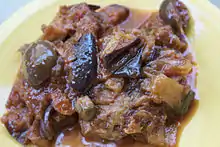Caponata
Caponata (Sicilian: capunata) is a Sicilian dish consisting of chopped fried eggplant and other vegetables, seasoned with olive oil, tomato sauce, celery, olives, and capers, in an agrodolce sauce.[1]
 Caponata | |
| Alternative names | Capunata |
|---|---|
| Type | Salad |
| Region or state | Sicily |
| Main ingredients | Aubergine |
| Ingredients generally used | Celery |
| Variations | Cianfotta |
Numerous local variants exist concerning the ingredients, by adding carrots, bell peppers, potatoes, pine nuts, and raisins.[2]
There is a Palermo version that adds octopus, and an aristocratic Sicilian recipe includes lobster and swordfish garnished with wild asparagus, grated dried tuna roe and shrimp.[3] However, these last examples are exceptions to the general rule of a sweet and sour cooked vegetable stew or salad.
Today, caponata is typically used as a side dish for fish dishes and sometimes as an appetizer, but since the 18th century it has also been used as a main course.
A similar Neapolitan dish is called cianfotta. The dish is also popular in Tunisian cuisine.
The dish may have been introduced to Sicily during the Arab conquests of the 9th century.[4]
Etymology
The etymology of the name is not entirely known. Some suggest it derives from the Catalan language, others that it comes from the caupone, the sailors' taverns.[5] The dishes described by Wright would suggest that in the past the Sicilian dish was similar to the Genoese capponata.
References
- Gangi, Roberta (2006). "Caponata". Best of Sicily Magazine. Retrieved 2008-05-26.
- Shulman, Martha Rose. "Caponata Recipe". NYT Cooking. Retrieved 2020-07-03.
- Phillips, Kyle. "Caponata alla Siciliana-The Baroness of Carni's Caponata". Retrieved 2008-08-27.
- Pope, Victoria. "Much of the Cuisine We Now Know, and Think of as Ours, Came to Us by War". Smithsonian Magazine. Retrieved 25 August 2020.
- Wright, Clifford A. (2008). "A History of the Sicilian Caponata". Archived from the original on 2008-06-04. Retrieved 2008-05-26.
External links
| Wikibooks Cookbook has a recipe/module on |
